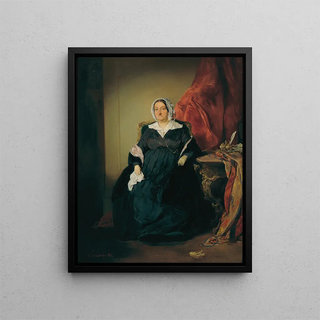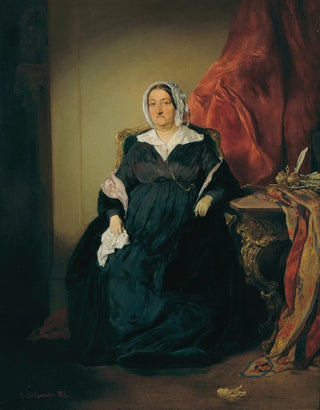Painting Elisabeth Imrdy Edle von Omorovicze - August von Pettenkofen | Art print


View from behind

Frame (optional)
In the vast panorama of art history, certain works stand out for their ability to capture the essence of a moment, an emotion, or a character. The art print Elisabeth Imrdy Edle von Omorovicze - August von Pettenkofen is a perfect example. This painting, both intimate and rich in history, immerses us in the world of a 19th-century aristocrat, offering a fascinating glimpse into the life and customs of the era. The depiction of Elisabeth Imrdy, an emblematic figure of high society, invites us to explore the nuances of her existence while revealing the technical and stylistic mastery of the artist.
Style and uniqueness of the work
The uniqueness of this piece lies in how August von Pettenkofen manages to blend realism and romanticism. The soft colors and meticulous details reflect a careful attention to the textures and lights. Every brushstroke seems to tell a story, with each shadow and reflection adding unprecedented depth to the composition. The choice of Elisabeth’s richly decorated clothing, along with her pensive expression, invites us to question her thoughts and aspirations. This painting is not merely a portrait; it is a window into a bygone era, an exploration of human feelings through the lens of art.
The artist and his influence
August von Pettenkofen, born in 1826, was a painter whose work was deeply influenced by the artistic currents of his time. Raised in an environment where art and culture were highly valued, he quickly developed a style that combined realism with romantic sensitivity. His work is marked by a desire for authenticity, aiming to capture the very essence of his subjects. Von Pettenkofen established himself as a renowned portraitist, his works appreciated both for their aesthetic quality and their storytelling ability. His influence is felt not only through his own creations but also in how he inspired other artists, contributing to the evolution of portraiture in the 19th century.
A wall decoration of

Matte finish

View from behind

Frame (optional)
In the vast panorama of art history, certain works stand out for their ability to capture the essence of a moment, an emotion, or a character. The art print Elisabeth Imrdy Edle von Omorovicze - August von Pettenkofen is a perfect example. This painting, both intimate and rich in history, immerses us in the world of a 19th-century aristocrat, offering a fascinating glimpse into the life and customs of the era. The depiction of Elisabeth Imrdy, an emblematic figure of high society, invites us to explore the nuances of her existence while revealing the technical and stylistic mastery of the artist.
Style and uniqueness of the work
The uniqueness of this piece lies in how August von Pettenkofen manages to blend realism and romanticism. The soft colors and meticulous details reflect a careful attention to the textures and lights. Every brushstroke seems to tell a story, with each shadow and reflection adding unprecedented depth to the composition. The choice of Elisabeth’s richly decorated clothing, along with her pensive expression, invites us to question her thoughts and aspirations. This painting is not merely a portrait; it is a window into a bygone era, an exploration of human feelings through the lens of art.
The artist and his influence
August von Pettenkofen, born in 1826, was a painter whose work was deeply influenced by the artistic currents of his time. Raised in an environment where art and culture were highly valued, he quickly developed a style that combined realism with romantic sensitivity. His work is marked by a desire for authenticity, aiming to capture the very essence of his subjects. Von Pettenkofen established himself as a renowned portraitist, his works appreciated both for their aesthetic quality and their storytelling ability. His influence is felt not only through his own creations but also in how he inspired other artists, contributing to the evolution of portraiture in the 19th century.
A wall decoration of
12,34 €






